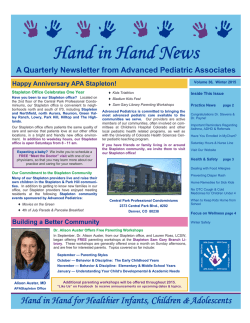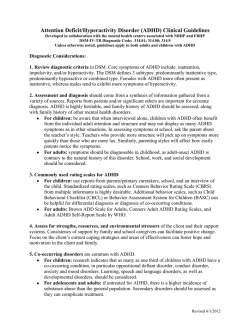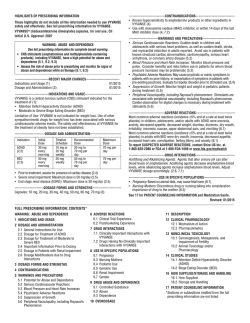
Cognitive and executive functions in ADHD
Original Guillermina Yáñez-Téllez1 Helena Romero-Romero1 Liliana Rivera-García1 Belén Prieto-Corona1 Jorge Bernal-Hernández1 Erzsebet Marosi-Holczberger1 Vicente Guerrero-Juárez1 Mario Rodríguez-Camacho1 Juan F. Silva-Pereyra1 Cognitive and executive functions in ADHD 1 Neuroscience Project Facultad de Estudios Superiores Iztacala Universidad Nacional Autónoma de México Introduction. Some studies have reported that attention-deficit/hyperactivity disorder (ADHD) children show alterations in different cognitive functions. Recently, a deficiency in the executive functions (EF) is proposed as the cause underlying all of these symptoms. However discrepancies exist about these findings. Objective. Assessment of cognitive and executive functions of subjects with both ADHD hyperactive-impulsive type and combined type, in order to reveal their neuropsychological characteristics and analyze if those functions are related to hyperactive-impulsive behavior. Method. Neuropsychological Battery, Stroop test, Wisconsin Card Sorting test and London Tower test were applied to 51 children between 7 and 12 years old (25 controls and 26 ADHD). Results. ADHD children showed worst performance in sustained attention, rapid serial naming of figures and colors, comprehension of written instructions, word dictation, number comparison, arithmetical problems, visual working memory, long term memory and the scores of WCST. Variables related to hyperactivity-impulsivity were: errors and decreased velocity in rapid serial naming of colors and figures, comprehension of written instructions, arithmetical problems and the scores of total errors, perseverating errors and perseverating responses of WCST. Conclusion. ADHD children show a great variety of cognitive deficiencies and had deficit only in some domains of executive functions. These deficiencies could explain to some extent the hyperactive and impulsive behavior. Key words: ADHD, Cognitive functions, Executive functions, Hyperactivity, Neuropsychology. Funciones cognoscitivas y ejecutivas en el TDAH Introducción. Se han observado alteraciones en diferentes funciones cognoscitivas en niños con Trastorno por Déficit de Atención con Hiperactividad (TDAH) y recientemente se ha propuesto que la causa que subyace a toda la sintomatología es una deficiencia en las funciones ejecutivas (FE), no obstante, existen muchas discrepancias en los hallazgos. Objetivo. Realizar una evaluación amplia de las funciones cognoscitivas y FE en niños con TDAH tipos hiperactivoimpulsivo y combinado (TDAH/HI-C) para conocer sus características neuropsicológicas y analizar que funciones pueden relacionarse con su conducta hiperactivo-impulsiva. Metodología. Se aplicó una Batería Neuropsicológica y los Test de Stroop, de Clasificación de tarjetas de Wisconsin (WCST) y Torre de Londres a 51 niños de 7 a12 años de edad (25 control y 26 con TDAH). Resultados. El grupo TDAH/HI-C tuvo peor resultado en atención sostenida, denominación serial rápida de figuras y colores, comprensión de órdenes escritas, dictado de palabras, comparación de números, problemas aritméticos, memoria de trabajo visual y de largo plazo y en el WCST. Los errores y velocidad en denominación serial rápida de colores y figuras, comprensión de órdenes escritas, problemas aritméticos, y del WCST errores totales, perseverativos y respuestas perseverativas, fueron las variables que se relacionaron con la hiperactividad-impulsividad. Conclusiones. Los niños con TDAH/HI-C tienen una gran variedad de deficiencias cognoscitivas y solamente en algunas áreas de las FE. Estas deficiencias explican en alguna medida el comportamiento hiperactivo-impulsivo. Palabras clave: TDAH, Funciones cognoscitivas, Funciones ejecutivas, Hiperactividad, Neuropsicología Actas Esp Psiquiatr 2012;40(6):293-8 INTRODUCTION Correspondence: Dra. Guillermina Yáñez Téllez Av de los Barrios No. 1, Los Reyes Iztacala, Tlanepantla, Estado de México, México CP 54090 Fax. 52 55 5390 7604 E-mail: [email protected] In accordance with the Diagnostic and Statistical Manual of Mental Disorders, fourth edition revised,1 Attention Deficit Hyperactivity Disorder (ADHD) has three Actas Esp Psiquiatr 2012;40(6):293-8 293 Guillermina Yáñez-Téllez, et al. Cognitive and executive functions in ADHD principal groups of symptoms: inattention, hyperactivity and impulsivity. According to the greater or lesser prevalence of these symptoms, ADHD is classified into the subgroups of predominately inattention, predominantly hyperactivity-impulsivity and combined, the latter with symptoms of inattention and hyperactivity-impulsivity. This disorder very frequently occurs in the school aged population, with an estimated prevalence of 3 to 7%.1 in mind that they will need to guide their subsequent actions and disorganized in their thinking, to the point of losing sight of the objective of their activities. Miranda-Casas et al.16 observed that the performance of children with ADHD on a temporo-visuospatial WM task was worse during a memory delay for inverse digits compared to NC children, although the same was not found in temporal-visuospatial WM without delay and digits in direct order. Characterization of ADHD from the neuropsychological point of view has been a widely debated subject. Barkley2 proposed the hypothesis of an underlying deficiency in executive functions (EF), specifically in behavior inhibition, for the hyperactive-impulsive and combined subtypes. Contradictory findings have been found in empirical works conducted to test the hypothesis of EF deficiencies. Cantrill3 observed that the ADHD group had deficient performance in inhibition and sense of time, but not in working memory (WM). On their part, Stevens et al.4 observed that children with ADHD had deficits in inhibitory control, WM and short-term memory. In this sense, Shallice5 studied the EFs of children with ADHD based on reaction time, sustained attention, vigilance, completing statements, knowledge of spatial rules, fluency, stop type tasks and WM. They found that these children were more deficient than a control group in all the tasks, except for the fluency task. On the contrary to the previous findings, when Scheres et al.6 compared children with ADHD with normal controls (NC), from the beginning they observed deficits in control of interference, inhibition, planning and letter fluency. After controlling for age and IQ, none of the deficits were maintained. Equally, Geurts et al.7 did not find support for the deficit hypothesis in the EFs of children with combined ADHD and in a meta-analysis, Schwartz and Verhaeghen also did not detect any deficiencies in control of interferences8. Regarding reading in children with ADHD, some authors have not detected differences between normal control and ADHD children,17 while others have observed clear deficiencies in some aspects such as reading of pseudowords.18-20 Regarding calculation, deficiencies have been found in children with ADHD in oral, and written calculation and math problems,15 although the latter finding has not been consistent.16 One of the principal symptoms of ADHD is sustained attention deficit. Nonetheless, its verification by objective methods has also been inconsistent. Some findings in the application of the continuous task execution (CTE) to evaluate sustained attention have been greater rate of omission and commission errors in children with ADHD compared to normal controls (NC).9 However, other studies have not observed this pattern.10 In relation to language, it has been proposed that children with ADHD have problems with phonological tasks,11, 12 morphosyntactic skills,12 semantic processing,13 naming speed for colors and figures14 and for letters and colors15. Regarding memory, Barkley2 stated that persons with ADHD have problems with WM so that they are described as forgetful, incapable of maintaining important information 294 As has been mentioned, different investigations have shown that the cognitive deficiencies in ADHD children are quite varied, although these results have not been consistent. These studies were conducted using samples chosen with different criteria according to the different generations of the manuals of the American Psychiatric Association.1 In general, the subtypes were not differentiated in the earliest works and the cognitive functions studies were not always the same in the different works. For these reasons, it is likely that the characterization of ADHD from the neuropsychological point of view is still a controversial subject. Consequently, studies are needed that jointly approach those functions in which deficiencies may exist in children with ADHD using more homogeneous samples based on clear criteria such as those presented in the DSM-IV-TR.1 This could make it possible to determine if any or some of the possible cognitive deficiencies of the children with ADHD could explain the behavioral symptoms or their severity. This study aimed to describe the cognitive functioning of children with hyperactive-impulsive and combined type ADHD. In this study, most of the functions studied in the literature in a single population were evaluated and it was attempted to determine the possible deficiencies that could be related with the behavioral symptoms and their severity. Knowing the cognitive functioning of children with ADHD may be very useful in the planning of adequate intervention strategies for this population. Currently, the intervention models are basically pharmacological and some are based on the application of behavior modification techniques.21 In spite of the utility of these techniques, neuropsychological intervention is advisable to favor the longer-term cognitive changes. Actas Esp Psiquiatr 2012;40(6):293-8 Guillermina Yáñez-Téllez, et al. Cognitive and executive functions in ADHD METHODOLOGY Subjects Two groups of children were studied, one with hyperactive-impulsive and combined subtypes of ADHD (ADHD/HI-C), without drug or psychological treatment, and a group of normal control children (NC). The ADHD/HI-C group was made up of 26 male children, 7 to 12 years of age, mean age of 8.6 years, from the Regular School of the City of Mexico Service Support Units. These units are made up of specialist groups that provide support within the public schools to children with different learning problems or problems of integration into a regular group. DSM-IV-TR criteria for hyperactive-impulsive and combined subtypes1 and the Conners Scale-Revised22 were used for their selection. The scale was answered by both the parents and teachers. The requirement was that they would reach the cutoff in one or some of the two subtypes mentioned in both evaluation. Only children with normal IQ who did not have learning problems, who had not repeated any course during their schooling and who did not have any other neurological complication, were included. The control group was made up of 25 males with normal IQ, with similar ages to the ADHD group (mean 9 years) and from the same schools as the children of the study group, without learning or behavior disorders and rule scores on the Conners Scale -Revised22 did not surpass the cutoffs, in addition to having a normal neurological evaluation. Instruments For the selection of the subjects: 1. Structured interview. 2. Wechsler Intelligence Scale for Children -Revised (WISC-R). 3. Conners Scale- Revised, Farré-Riba and Narbona version.22 This scale contains 20 items, 5 of which correspond to hyperactivity-impulsivity, 5 others to inattention and 10 to behavior disorders. For the neuropsychological evaluation: 1. Neuropsychological battery for children (NBC).23 It contains tests to evaluate different functions: 1) Attention (CTE); 2) Language: phonological processing, (analysis and synthesis tasks), rapid serial naming (RSN) (digits, letters, colors, figures), repetition, understanding or orders, vocabulary (receptive and expressive); 3) Reading words, lexical decision and understanding of instructions; 4) Writing of words; 5) Arithmetic (oral calculation, written calculation, comparison of numbers and arithmetic problems), 6) short term memory, WM and long term memory. It has rules for children 7 to 12 year of age and all the tests have an internal consistency reliability of >0.70. 2. Tower of London.24 This fundamentally evaluates planning and problem solving capacity. 3. The Stroop Color Word test.25 One of its objectives is the evaluation of one of the aspects of executive functions: control of interference. 4. Wisconsin Card Sorting Test (WCST).26 This evaluates abstract reasoning and cognitive flexibility. Procedure An informed consent was obtained from the parents for all the children. After, a structured interview was administered to the parents to obtain the clinical history data. Those children who had repeated any academic course or were reported to have learning problems at school did not go on to the next phases. During a second session, the WISC-R was applied and a neurological evaluation was made. Those children with normal IQ, without neurological disorders, whose parents and teachers answered the Conners Scale-Revised,22 remained in the study. The NBC and executive function tests were applied in two consecutive days. Analysis Using the scores derived from each one of the subtests as dependent variables, a T test was conducted among the NC groups and the ADHD/HI-C. After, a multiple linear regression analysis with the backward method was applied in regards to those variables that showed differences between groups in order to obtain the best combination of variables that would predict hyperactivity-impulsivity symptoms as evaluated with the behavioral scales. RESULTS Table 1 describes the demographic and I.Q characteristics of the children of the control group and those with ADHD/ HI-C. There were no significant differences between the groups in any of the variables mentioned. (Table 1) Neuropsychology Battery Attention In the paper and pencil continuous task execution (CTE), the ADHD/HI-C group showed a lower rate of detection of the white stimulus than the control group [t(49)=2.78, Actas Esp Psiquiatr 2012;40(6):293-8 295 Guillermina Yáñez-Téllez, et al. Table 1 Cognitive and executive functions in ADHD Demographic characteristics and intelligence quotient of the control and ADHD/HI-C groups 50 ADHD 25 26 9.0 (1.7) 8.6 (1.7) Verbal Intelligence Quotient 109.6(12.6) 106.8 (12.4) Executive Intelligence Quotient 108 (15.5) 104.5 (11.8) 109.8 (14.3) 106.4 (12) Age in years Total Intelligent quotient p=0.008], with means of 32.5 and 44.2, respectively. There were no significant differences in the errors. seconds segundos N Control Control ADHD TDAH 60 Mean (SD) Control * 70 40 30 20 10 0 Digits Dígitos Figure 1 Letters Letras Colors Colores Figures Figuras Comparison of the control and ADHD/ HI-C groups in the rapid serial naming task for different categories of stimuli Language Significant differences were only obtained in the rapid serial naming task for figures [t(49)= -3.09, p=0.003] and colors [t(49)=-2.69, p=0.01], where the ADHD/HI-C group took longer to carry out the tasks (Fig. 1). There were also statistically significant differences in the total amount of errors on the rapid serial naming (RSN) with a greater amount for the ADHD/HI-C group [t(49)=-3.05, p=0.004]. (Figure 1) Reading and writing There were no significant differences in reading of words speed and accuracy or in a lexical decision task. Significant differences were only observed in the understanding of written instructions [t(49)=2.37, p=0.02], with less performance for the ADHD /HI-C group. In the dictation of frequent words, a significant difference was observed, with more correct answers for the NC group [t(49)=2.57, p=0.013]. Arithmetic A significant difference was found in the comparison of numbers [t(49)=2.22, p=0.031] and arithmetic problems [t(49)=2.06, p=0.045]. There was better performance for the NC group in both cases. There were no significant differences in oral calculation, written calculation and number naming. [t(49)=2.26, p=0.028] and memories with clues [t(49)=2.042, p=0.047]. In every case, there was less performance for the ADHD/HI-C. Executive functions tests No statistically significant differences were observed between groups with the Tower of London and Stroop Tests. In the WCST, the ADHD group showed a greater amount of total errors, perseverative errors and perseverative responses as well as a lower number of answers on the conceptual level compared to the CN group (Table 2). Relation between cognitive deficits and hyperactive-impulsive behavior In a multiple linear regression analysis with the backward method, it was observed that the combination of variables that best predicted severity of the hyperactivity-impulsivity symptoms evaluated with the Conners Scale22 were: errors in rapid serial naming (RSN) and speed in naming colors and figures (RSN), understanding of written instruction (RSN), arithmetic problems (RSN), perseverative errors (WCST), total errors (WCST) and perseverative responses (WCST) R2=0.69 [F (8,27)=7.38; p=0.000] with an elevated level of statistical significance. Memory No significant differences were found in short-term memory tasks. In WM, there were significant differences [t(49)=2.002, p=0.05] only in the visual modality. Significant differences were found in the free long-term memory 296 CONCLUSION This work has aimed to discover the cognitive functioning of children with ADHD/HI-C and then to try to determine which Actas Esp Psiquiatr 2012;40(6):293-8 Guillermina Yáñez-Téllez, et al. Table 2 Cognitive and executive functions in ADHD Comparison between the control group and the ADHD/HI-C on the Wisconsin Card Sorting Test Groups Percentiles Total errors Control ADHD t Control Mean (SD) Control Mean (SD) 51.86 (20.8) 32.42 (23.1) 2.932 p .005 Perseverative responses 48.43 (23.1) 29.76 (23.0) 2.688 .01 Perseverative errors 49.56 (23.0) 31.04 (22.3) 2.703 .01 Non-perseverative errors 58.65 (23.0) 49.57 (29.0) 1.156 .25 Percentage of responses on the conceptual level 44.43 (18.2) 30.90 (21.4) 2.260 .02 alterations can explain the behavioral symptoms and their severity. In accordance with the results, the characteristics that distinguish ADHD/HI-C children with normal I.Q. from NC children are lower performance on sustained attention tasks, greater number of errors and more time to perform rapid serial naming tasks of figures and colors as well as more errors in the understanding of written instructions and in word dictation. Furthermore, they had deficiencies in arithmetic tasks of comparison of numbers and problem solving. Regarding memory, problems were observed in visual WM and long-term memory. On the other hand, they had more total and perseverative errors on the WCST, that is, these children had less cognitive flexibility than the control children. The RSN variables that predict hyperactivity-impulsivity grade are: errors in rapid serial naming, speed to name figures and colors and understanding of written instructions. From the WCST, the variables are perseverative errors, total errors and perseverative responses. Our results agree with some of the works published. Although there is controversy in determining if there are alterations in sustained attention in ADHD/HI-C children, in our study these children had a lower number of correct answers on continuous task execution (CTE), these results coinciding with those obtained by Losier et al.10 One finding that can be directly related with an inattention symptom in children with ADHD/HI-C, which is referred to in the DSM-IV TR1 as that “they do not to listen when spoken to and do not follow instructions,” is lower performance in understanding or orders tasks, both orally and written, although only the latter was significant. calculation. Thus, it can be concluded that the problem that children with ADHD/HI-C have is not one of calculation per se, but rather that this deficiency could be secondary to attention and working memory problems. As referred to in the literature,16 significant differences were not observed in short-term memory tasks. In WM, which according to the hypothesis of Barkley2 would be one of the most altered functions, we only detected lower performance in the ADHD/HI-C group in the visual modality, similar to that observed in another study.16 For the free long-term memory, for which we do not know the previous data, a deficit of the ADHD/HI-C children was observed in the coding of visual information and of maintaining it in the long-term memory. Despite this pattern of results, we also observed some important inconsistencies regarding the already published data. It has been postulated that one of the principal alterations underlying ADHD/HI-C is a deficit in the executive functions (EF).2 In this study, three of the tests that are prototypical of the functioning of different areas of EF were applied, and significant differences were only obtained in the cognitive flexibility test. Thus, overall, it cannot be said that the EF deficiencies are those that determine the impulsivity and hyperactivity problems in these children. These seem to be confined to deficiencies in abstract reasoning and cognitive flexibility. Coinciding with other studies14, 15 in the rapid serial naming of colors and figures task, children with ADHD/HI-C were slower and had more errors than the normal control group children. We consider that the cognitive deficiencies in ADHD found in different studies are probably due to the comorbidity that occurs with the learning disorders and when they are not adequately ruled out, they may contribute to the differences observed. We think that more studies that analyze the altered skills jointly in these children need to be conducted in order to determine the neuropsychological profile of this population more consistently. As we have previously observed,15 children with ADHD/HI-C had lower performance in arithmetic problem solving. However, we did not observe significant differences in oral and written The study of the cognitive functions of children with ADHD/ HI-C may be useful to begin to establish a fixed neuropsychological battery to perform a standardized evaluation of this population. Actas Esp Psiquiatr 2012;40(6):293-8 297 Guillermina Yáñez-Téllez, et al. Cognitive and executive functions in ADHD Research carried out thanks to the Program of Support to Research and Technology Innovation Program (PAPIIT) of the UNAM IN307311-3 references 1. Asociación Psiquiátrica Americana. DSM-IV TR, Manual Diagnóstico y Estadístico de los Trastornos Mentales. Barcelona: Masson, 2003. 2. Barkley RA. Behavioral inhibition, sustained attention, and executive functions: Constructing a unifying of ADHD. Psychol Bull. 1997;121:65-94. 3. Cantrill JL. Inhibition, working memory and time sense in children with attention deficit hyperactivity disorder. Dissertation Abstracts Internacional Section B: The sciences & Engineering. 2003;63:7B. 4. Stevens J, Quittner A, Zuckerman JB, Moore S. Behavioral inhibition, self regulation of motivation, and working memory in children with attention deficit hyperactivity disorder. Deve Neuropsychol. 2002;21(2):117-40. 5. Shallice T, Marzocchí GM, Coser J, Del Savio M, Meuter RT, Rumiati R. Executive function profile of children with attention deficit hyperactivity disorder. Dev Neuropsychol. 2002;21(1):4371. 6. Scheres A, Oosterlaan J, Geurts H, Morein-Zamir S, Meiran N, Schut H, et al. Executive functioning in boys with ADHD: primarily an inhibition deficit? Arch Clin Neuropsychol. 2004;19:569-94. 7. Geurts HM, Verté S, Oosterlaan J, Roeyers H, Sergeant JA. ADHD subtypes: Do they differ in their executive functioning profile? Arch Clin Neuropsychol. 2005;20:457-77. 8. Schwartz K, Verhaeghen P. ADHD and Stroop interference from age 9 to age 41years: a meta-analysis of developmental effects. Psychol Med. 2008;38:1607-16. 9. Oades RD. Differential measures of “sustained attention” in children with attention-deficit/hyperactivity or tic disorders: relations to monoamine metabolism. Psychiatry Res. 2000;93:165-78. 10. Losier BJ, McGrath PJ, Klein RM. Error patterns on the continuous performance test in non-medicated and medicated samples of children with and without ADHD: A meta-analytic review. J Child Psychol Psychiatry. 1996;37:971-87. 11. Miranda-Casas A, Ygual-Fernández A, Mulas-Delgado F, RosellóMiranda B, Bó RM. Procesamiento fonológico en niños con trastorno por déficit de atención con hiperactividad: ¿Es eficaz el metilfenidato? Rev Neurol. 2002;34:S115-21. 12. Ygual-Fernández A, Miranda-Casas A, Cervera-Mérida J. Dificultades en las dimensiones de forma y contenido del 298 lenguaje en los niños con trastorno por déficit de atención con hiperactividad. Rev Neurol. 2000;1:193-202. 13. Idiazábal A, Guerrero-Gallo D, Sánchez-Bisbal MM. Déficit en el procesamiento semántico. Rev Neurol. 2006;42:S29-36. 14. Tannock R, Martinussen R, Frijters J. Naming speed performance and stimulant effects indicate effortful, semantic processing deficits in attention-deficit/hyperactivity disorder. J Abnorm Child Psychol. 2000;28:237-52. 15. Yáñez TG, Romero RH, Bernal HJ, Marosi HE, Rodríguez CM, Guerrero JV, 3t al. Trastorno por déficit de atención con hiperactividad (TDAH): coeficiente intelectual y funciones cognoscitivas. Rev Mex Psicol. 2005;22 1):31-41. 16. Miranda-Casas A, Meliá-de Alba A, Marco-Taverner R, Roselló B, Mulas F. Dificultades en el aprendizaje de las matemáticas en niños con trastorno por déficit de atención con hiperactividad. Rev Neurol. 2006;42:S163-70. 17. Marshall RM, Hynd GW, Handwerk MJ, Hall J. Academic underachievement in ADHD subtypes. J Learn Disabil. 1997;30:635-42. 18. Barkley RA, Dupaul GJ, McMurray MB. A comprehensive evaluation of attention deficit disorder with and without hyperactivity as defined as research criteria. J Consult Clin Psychol. 1990;58:775-89. 19. Gratch L. El trastorno por déficit de atención (ADD-ADHD): Clínica, diagnóstico y tratamiento en la infancia, la adolescencia y la adultez. Buenos Aires: Editorial Médica Panamericana, 2000. 20. Miranda A, García R, Jara P. Acceso al léxico y comprensión lectora en los distintos subtipos de niños con trastorno por déficit de atención con hiperactividad. Rev Neurol. 2001;2(1):125-38. 21. Goldstein S, Goldstein M. Managing attention deficit hyperactivity disorder in children. New York: John Whiley and Sons Inc, 1998. 22. Farré-Riba, Narbona J. Escalas de Conners en la evaluación del trastorno por déficit de atención con hiperactividad: nuevo estudio factorial en niños españoles. Rev Neurol. 1997;25(138):200-4. 23. Yánez G, Bernal J, Harmony T, Marosi E, Rodríguez M. Batería neuropsicológica para niños con trastornos del aprendizaje de la lectura (BNTAL): Obtención de normas. Rev Latina de Pensamiento y Lenguaje. 2002;2:249-69. 24. Culbertson W, Zillmer E. Tower of London. Toronto: Drexel University MHS, 1999. 25. Golden C. Stroop: Test de colores y palabras. Madrid: TEA, 2001. 26. Heaton R, Chelune G, Talley J, Kay G, Curtiss G. Test de Clasificación de tarjetas de Wisconsin. España: TEA, 1997. Actas Esp Psiquiatr 2012;40(6):293-8
© Copyright 2026



